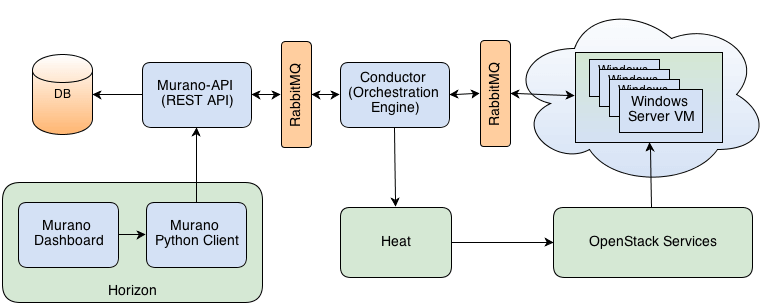Murano 0.2 is here!
After three months of development and refinement, the Murano Team is happy to announce the release of Murano v0.2. Murano introduces a service that allows any user to deploy reliable Windows-based environments at the push of a button. To address these unique user needs, Murano:
- Is native to OpenStack.
- Introduces an abstraction level for Windows environments.
- Supports Availability Zones and Disaster Recovery scenarios.
- Uses native Windows features for High Availability (HA) solutions.
The Murano Service communicates with the following OpenStack components:
Figure 1. Murano architecture
- Horizon—Provides a GUI with the ability to use all Murano features.
- Keystone—Authenticates users and provides the security token that is used to work with OpenStack, hence limiting the user’s abilities in Murano based on OpenStack privileges.
- Heat—Used to provision VMs and other OpenStack resources for Windows Environments.
- Glance—Stores Windows Server VM images, with each image containing an installed OS and a set of scripts.
- Quantum—Provides the network configuration API.
- Agent—Provides agent functionality to communicate with the Conductor (Orchestration Engine) and executes tasks on VMs.
What’s new in Murano 0.2?
Murano 0.2 includes the following new features:
- Workflow diagnostics in Murano Conductor. The XML workflow definition language now has new tags to provide more precise control over workflow execution, report various error conditions and warnings, and create “one-off” rules.
- Dynamic UI. Form definitions, data processing logic and text from Python code and Django templates have been moved into separate service definitions in the human-readable YAML format. Separating service definitions from Python code provides a much greater flexibility in adding, modifying, and removing services. The format is simple enough for non-programmers—even if there are some errors in a service’s definition, it won’t crash the whole dashboard; it simply won't be shown in services list. The dynamic UI employs YAML for forms markup and YAQL (Yet Another Query Language, developed especially for Murano Workflows) for form validation and initialization logic.
- Support for SSL both in REST API and RabbitMQ communications. To improve security in Murano, the team has added support for SSL on all communication levels between components, and you now have the ability to secure all communications with the Murano API by using the SSL endpoint in our REST API service.
- Ability to select instance flavor, Windows image, and availability zone. A new common dialog step, which allows users to select an instance flavor (hardware configuration), a Windows image (pre-created Glance image, marked with an appropriate metadata tag), and an availability zone (as defined within OpenStack), has been added to the Create Service UI.
- External Active Directory. Implemented as the Conductor's functionality extension, External Active Directory becomes available after enabling the ExternalAD.xml workflow template in the Murano Conductor service. This feature allows you to use most of the Murano-supported services with the existing Windows domain.
The new release also provides these additional services:
- MS SQL Single Instance. This type of service provides deployment of the MS SQL Server 2012 in standalone mode per instance.
- MS SQL Server AlwaysOn Cluster. This type of service is the most complex of all supported services. It actually contains the services under the hood—Active Directory and MS SQL Server Cluster.
In addition to these new features and various bug fixes to the WebUI, Conductor, and Dashboard, the team has also made the following improvements to Murano:
- Added detailed documentation for writing XML Workflows.
- Improved HA for Murano Conductor.
- Provided REST API generalization.
You can find the full release notes and other information (Getting Started Guide, Administrator Guide, Developer Guide, and so on) on the Murano project Wiki. You can also check out the complete list of bugs fixed in Murano v0.2.
Where to go for more information
The team has created two new screencasts about product deployment and features for this release:
- Introduction: Common information about Murano with deployment of ASP.NET Web Farm as an example
- Murano v0.2 features: Deployment of MS SQL AlwaysOn with Active Directory
You can also check out these resources to find more information about Murano:
- Murano Wiki: https://wiki.openstack.org/wiki/Murano
- Launchpad Project: https://launchpad.net/murano
- IRC channel: #murano at FreeNode.







